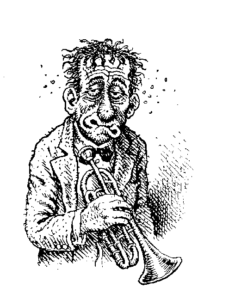The Soundwise Embouchure
The instrument of the woodwind player really appears to behave as his megaphone, thanks to his embouchure.
Get Your Mask Down !
Your mouth / mouthpiece / reed / ligature set defines your global embouchure : this configuration may vary between players, closely associating your morphology and the gear you use.
Your inner resonance propagates to the reed, which should easily vibrate, opposing a low resistance, hence a not too hard reed is recommended in order to be able to master the depth of the sound, shaped up at the bottom of the air column (Peter King had told me once how he had bee surprised to see that Cannonball Adderley was playing a really weak reed, when he substituted him in England in the 70’s).
This way, you define the best mouthpiece/reed combination for your sound control : this compromise depend on several factors, but you must know how to adjust it, mainly by selecting an appropriate reed, with your usual mouthpiece. And if you need a softer reed to ease out your playing, then you would be able to modulate your reed strength later on, bringing full balance and self-confidence : through your mentally visualizing that your emission remains centered on the sound source, you avoid unnecessary contractions above your diaphragm (which would be triggered by a harder reed), following the recommendations of Alfred Tomatis in The Ear And The Voice.
deep throat
By focusing on the opening of his sound column backward and downward – and willing to prononce the « ah » vowel -, the player forgets about his real trunk and his embouchure, thus ensuring that his throat remains free of contractions.
« The objective for both the pharynx and the larynx is to keep the throat open and supple, avoiding closure by the constrictor muscles. The regulation of the pharynx under the organizing control of the ear consists of achieving what is famous in singing as the open throat with the help of the dilator muscles and the tongue.»
Alfred Tomatis, The Ear And The Voice
As Joe Allard liked to emphasize it, the mouthpiece should be understood as an extension of the mouth, and the reed as an extension of the tongue : reverting this picture, the global embouchure extends, mentally and in your belly, down to the Hara point, and you then sing in your instrument from this central point.
© iTunes / Joe Allard – Lessons from the Master Teacher
Think Your Sound, But Do Not Pinch It
The wind player sets up his vibrating attitude by rooting his sound column in his heels, and mentally pictures his embouchure at the sound source, down to the bottom of his diaphragm : then, letting the relaxation down, his inner vibration gently takes off on the « ah » vowel, to feed the instrument through his embouchure.
Dominique Hoppenot describes how the violon player lets his vibration propagate to the violon body through his clavicle.
« The most important of all is to listen to the sound that will come and not just to the sound already achieved. »
Dominique Hoppenot, Le violon intérieur (Translated by Guy Robert)
Une fois sa posture installée, l’instrumentiste amène naturellement son instrument en mains (et en bouche pour un soufflant) pour amplifier le son préparé à l’avance ; alors entre en jeu l’embouchure, souple et décontractée, et même oubliée, car son attention est concentrée sur la base de la colonne de son : là se réalise la liaison entre l’émetteur (le corps de l’instrumentiste) et l’amplificateur (le corps de l’instrument), dont la projection sonore est ensuite travaillée par les doigts, puis par la langue.
Once your posture is set up and stabilized, your hands naturally seize your instrument (entering your mouth if you are a wind player), to amplify the anticipated sound ; then your flexible and relaxed embouchure, which you actually forget, since you are focussed on the bottom of the sound column, comes into play : it links you, as the sender (the player’s body), to the amplifier (the instrument body). The projected sound gets then sculpted out by your fingers, and your tongue.
« You should forget all about your embouchure positioning, and be sure not to press it.«
Robert Pichaureau, Expressions favorites (Translated by Guy Robert)
« The goal is to be as relax as possible in the embouchure area, so that the delicate mechanisms at the reed can be free to occur without exerting a strain on its vibrational capacity. By the time the air stream reaches the mouthpiece, the major portion of the work for a personal sound has already been completed.«
David Liebman, Developing A Personal Saxophone Sound
When you let your mouthpiece come to your mouth, enjoyment also enters as an intruding momentum. The same way as when you take momentum to jump over an obstacle, boom ! there it goes, you are played by your instrument, so you should not play yourself, this is not a wordplay.
As little as your embouchure takes off, then you nail your mouthpiece pinch, without looking for it, playing means then sitting on the air, this is fantastic !
Robert Pichaureau, A tous vents (Translated by Guy Robert)
« Generally, I prefer closer mouthpieces, but I try to find the combination of the length of the facing and the tip opening so that I don’t have to press hard to play it, so that everything feels easy.«
Eddie Daniels on Mouthpieces and Ligatures
© YouTube – Backun Musical Services

